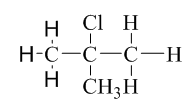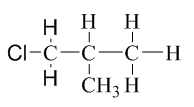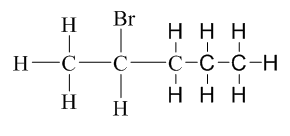
Bundle: Chemistry: The Molecular Science, 5th, Loose-Leaf + OWLv2 with Quick Prep 24-Months Printed Access Card
5th Edition
ISBN: 9781305367487
Author: John W. Moore, Conrad L. Stanitski
Publisher: Cengage Learning
expand_more
expand_more
format_list_bulleted
Concept explainers
Question
Chapter 7, Problem 30QRT
(a)
Interpretation Introduction
Interpretation:
Chiral centers in the given molecule have to be circled.

Concept Introduction:
Chirality: It refers to a Carbon atom in a molecule that contains four different substituents.
(b)
Interpretation Introduction
Interpretation:
Chiral centers in the given molecule have to be circled.

Concept Introduction:
Refer to (a).
(c)
Interpretation Introduction
Interpretation:
Chiral centers in the given molecule have to be circled.

Concept Introduction:
Refer to (a).
(d)
Interpretation Introduction
Interpretation:
Chiral centers in the given molecule have to be circled.

Concept Introduction:
Refer to (a).
Expert Solution & Answer
Want to see the full answer?
Check out a sample textbook solution
Students have asked these similar questions
Using reaction free energy to predict equilibrium composition
Consider the following equilibrium:
2NO2 (g) = N2O4(g)
AGº = -5.4 kJ
Now suppose a reaction vessel is filled with 4.53 atm of dinitrogen tetroxide (N2O4) at 279. °C. Answer the following questions about this system:
Under these conditions, will the pressure of N2O4 tend to rise or fall?
Is it possible to reverse this tendency by adding NO2?
In other words, if you said the pressure of N2O4 will tend to rise, can that
be changed to a tendency to fall by adding NO2? Similarly, if you said the
pressure of N2O4 will tend to fall, can that be changed to a tendency to
'2'
rise by adding NO2?
If you said the tendency can be reversed in the second question, calculate
the minimum pressure of NO 2 needed to reverse it.
Round your answer to 2 significant digits.
00
rise
☐ x10
fall
yes
no
☐ atm
G
Ar
1
Why do we analyse salt?
Curved arrows are used to illustrate the flow of electrons. Using
the provided starting and product structures, draw the curved
electron-pushing arrows for the following reaction or
mechanistic step(s).
Be sure to account for all bond-breaking and bond-making
steps.
H
H
CH3OH, H+
H
Select to Add Arrows
H°
0:0
'H
+
Q
HH
■ Select to Add Arrows
CH3OH,
H*
H.
H
CH3OH, H+
HH
■ Select to Add Arrows i
Please select a drawing or reagent from the question area
Chapter 7 Solutions
Bundle: Chemistry: The Molecular Science, 5th, Loose-Leaf + OWLv2 with Quick Prep 24-Months Printed Access Card
Ch. 7.2 - Identify the electron-region geometry, the...Ch. 7.2 - Based on the discussion so far, identify a...Ch. 7.2 - Prob. 7.2PSPCh. 7.2 - Determine the electron-region geometry and the...Ch. 7.2 - Prob. 7.2CECh. 7.2 - Prob. 7.3ECh. 7.2 - Prob. 7.4PSPCh. 7.4 - Using hybridization and sigma and pi bonding,...Ch. 7.4 - Prob. 7.4CECh. 7.5 - Decide whether each molecule is polar and, if so,...
Ch. 7.5 - Prob. 7.5ECh. 7.6 - Prob. 7.8PSPCh. 7.6 - Prob. 7.7CECh. 7.6 - Prob. 7.9PSPCh. 7.7 - Prob. 7.8CECh. 7.7 - Prob. 7.9CECh. 7 - Write the Lewis structures and give the...Ch. 7 - The structural formula for the open-chain form of...Ch. 7 - Describe the VSEPR model. How is the model used to...Ch. 7 - What is the difference between the electron-region...Ch. 7 - Prob. 3QRTCh. 7 - Prob. 4QRTCh. 7 - If you have three electron regions around a...Ch. 7 - Prob. 6QRTCh. 7 - Prob. 7QRTCh. 7 - Prob. 8QRTCh. 7 - Prob. 9QRTCh. 7 - Prob. 10QRTCh. 7 - Prob. 11QRTCh. 7 - Prob. 12QRTCh. 7 - Prob. 13QRTCh. 7 - Prob. 14QRTCh. 7 - Prob. 15QRTCh. 7 - Prob. 16QRTCh. 7 - Write Lewis structures for XeOF2 and ClOF3. Use...Ch. 7 - Write Lewis structures for HCP and [IOF4]. Use...Ch. 7 - Prob. 19QRTCh. 7 - Prob. 20QRTCh. 7 - Explain why (I3)+ is bent, but (I3) is linear.Ch. 7 - Prob. 22QRTCh. 7 - Prob. 23QRTCh. 7 - Give approximate values for the indicated bond...Ch. 7 - Give approximate values for the indicated bond...Ch. 7 - Prob. 26QRTCh. 7 - Compare the FClF angles in ClF2+ and ClF2. From...Ch. 7 - Prob. 28QRTCh. 7 - Prob. 29QRTCh. 7 - Prob. 30QRTCh. 7 - Prob. 31QRTCh. 7 - Describe the geometry and hybridization of carbon...Ch. 7 - Describe the geometry and hybridization for each C...Ch. 7 - Describe the hybridization around the central atom...Ch. 7 - The hybridization of the two carbon atoms differs...Ch. 7 - The hybridization of the two nitrogen atoms...Ch. 7 - Identify the type of hybridization, approximate...Ch. 7 - Prob. 38QRTCh. 7 - Prob. 39QRTCh. 7 - Prob. 40QRTCh. 7 - Prob. 41QRTCh. 7 - Methylcyanoacrylate is the active ingredient in...Ch. 7 - Prob. 43QRTCh. 7 - Prob. 44QRTCh. 7 - Prob. 45QRTCh. 7 - Prob. 46QRTCh. 7 - Which of these molecules has a net dipole moment?...Ch. 7 - Prob. 48QRTCh. 7 - Use molecular structures and noncovalent...Ch. 7 - Prob. 50QRTCh. 7 - Explain why water “beads up” on a freshly waxed...Ch. 7 - Explain why water will not remove tar from your...Ch. 7 - Prob. 53QRTCh. 7 - Prob. 54QRTCh. 7 - Prob. 55QRTCh. 7 - Prob. 56QRTCh. 7 - The structural formula for vitamin C is Give a...Ch. 7 - Prob. 58QRTCh. 7 - Prob. 59QRTCh. 7 - Prob. 60QRTCh. 7 - Prob. 61QRTCh. 7 - Prob. 62QRTCh. 7 - Prob. 63QRTCh. 7 - Prob. 64QRTCh. 7 - Prob. 65QRTCh. 7 - Prob. 66QRTCh. 7 - Methylcyanoacrylate is the active ingredient in...Ch. 7 - Prob. 68QRTCh. 7 - Prob. 69QRTCh. 7 - Use Lewis structures and VSEPR theory to predict...Ch. 7 - In addition to CO, CO2, and C3O2, there is another...Ch. 7 - Prob. 72QRTCh. 7 - Prob. 73QRTCh. 7 - Prob. 74QRTCh. 7 - Prob. 75QRTCh. 7 - In the gas phase, positive and negative ions form...Ch. 7 - Prob. 77QRTCh. 7 - Prob. 78QRTCh. 7 - Prob. 79QRTCh. 7 - Prob. 80QRTCh. 7 - Prob. 81QRTCh. 7 - Prob. 82QRTCh. 7 - Prob. 83QRTCh. 7 - Prob. 84QRTCh. 7 - Prob. 85QRTCh. 7 - Prob. 86QRTCh. 7 - Prob. 87QRTCh. 7 - Prob. 88QRTCh. 7 - Prob. 89QRTCh. 7 - Prob. 90QRTCh. 7 - Prob. 91QRTCh. 7 - Prob. 92QRTCh. 7 - Prob. 93QRTCh. 7 - Prob. 94QRTCh. 7 - Which of these are examples of hydrogen bonding?Ch. 7 - Prob. 96QRTCh. 7 - Prob. 97QRTCh. 7 - Prob. 98QRTCh. 7 - Halothane, which had been used as an anesthetic,...Ch. 7 - Ketene, C2H2O, is a reactant for synthesizing...Ch. 7 - Gamma hydroxybutyric acid, GHB, infamous as a date...Ch. 7 - There are two compounds with the molecular formula...Ch. 7 - Piperine, the active ingredient in black pepper,...Ch. 7 - Prob. 105QRTCh. 7 - Two compounds have the molecular formula N3H3. One...Ch. 7 - Prob. 108QRTCh. 7 - Prob. 109QRTCh. 7 - Prob. 110QRTCh. 7 - Prob. 111QRTCh. 7 - Prob. 7.ACPCh. 7 - Prob. 7.BCPCh. 7 - Prob. 7.CCPCh. 7 - Prob. 7.DCP
Knowledge Booster
Learn more about
Need a deep-dive on the concept behind this application? Look no further. Learn more about this topic, chemistry and related others by exploring similar questions and additional content below.Similar questions
- What are examples of analytical methods that can be used to analyse salt in tomato sauce?arrow_forwardA common alkene starting material is shown below. Predict the major product for each reaction. Use a dash or wedge bond to indicate the relative stereochemistry of substituents on asymmetric centers, where applicable. Ignore any inorganic byproducts H Šali OH H OH Select to Edit Select to Draw 1. BH3-THF 1. Hg(OAc)2, H2O =U= 2. H2O2, NaOH 2. NaBH4, NaOH + Please select a drawing or reagent from the question areaarrow_forwardWhat is the MOHR titration & AOAC method? What is it and how does it work? How can it be used to quantify salt in a sample?arrow_forward
- Predict the major products of this reaction. Cl₂ hv ? Draw only the major product or products in the drawing area below. If there's more than one major product, you can draw them in any arrangement you like. Be sure you use wedge and dash bonds if necessary, for example to distinguish between major products with different stereochemistry. If there will be no products because there will be no significant reaction, just check the box under the drawing area and leave it blank. Note for advanced students: you can ignore any products of repeated addition. Explanation Check Click and drag to start drawing a structure. 80 10 m 2025 McGraw Hill LLC. All Rights Reserved. Terms of Use | Privacy Center | Accessibility DII A F1 F2 F3 F4 F5 F6 F7 F8 EO F11arrow_forwardGiven a system with an anodic overpotential, the variation of η as a function of current density- at low fields is linear.- at higher fields, it follows Tafel's law.Calculate the range of current densities for which the overpotential has the same value when calculated for both cases (the maximum relative difference will be 5%, compared to the behavior for higher fields).arrow_forwardUsing reaction free energy to predict equilibrium composition Consider the following equilibrium: N2 (g) + 3H2 (g) = 2NH3 (g) AGº = -34. KJ Now suppose a reaction vessel is filled with 8.06 atm of nitrogen (N2) and 2.58 atm of ammonia (NH3) at 106. °C. Answer the following questions about this system: rise Under these conditions, will the pressure of N2 tend to rise or fall? ☐ x10 fall Is it possible to reverse this tendency by adding H₂? In other words, if you said the pressure of N2 will tend to rise, can that be changed to a tendency to fall by adding H2? Similarly, if you said the pressure of N will tend to fall, can that be changed to a tendency to rise by adding H₂? If you said the tendency can be reversed in the second question, calculate the minimum pressure of H₂ needed to reverse it. Round your answer to 2 significant digits. yes no ☐ atm Х ด ? olo 18 Ararrow_forward
- Four liters of an aqueous solution containing 6.98 mg of acetic acid were prepared. At 25°C, the measured conductivity was 5.89x10-3 mS cm-1. Calculate the degree of dissociation of the acid and its ionization constant.Molecular weights: O (15.999), C (12.011), H (1.008).Limiting molar ionic conductivities (λ+0 and λ-0) of Ac-(aq) and H+(aq): 40.9 and 349.8 S cm-2 mol-1.arrow_forwardDetermine the change in Gibbs energy, entropy, and enthalpy at 25°C for the battery from which the data in the table were obtained.T (°C) 15 20 25 30 35Eo (mV) 227.13 224.38 221.87 219.37 216.59Data: n = 1, F = 96485 C mol–1arrow_forwardIndicate the correct options.1. The units of the transport number are Siemens per mole.2. The Siemens and the ohm are not equivalent.3. The Van't Hoff factor is dimensionless.4. Molar conductivity does not depend on the electrolyte concentration.arrow_forward
- Ideally nonpolarizable electrodes can1. participate as reducers in reactions.2. be formed only with hydrogen.3. participate as oxidizers in reactions.4. form open and closed electrochemical systems.arrow_forwardIndicate the options for an electrified interface:1. Temperature has no influence on it.2. Not all theories that describe it include a well-defined electrical double layer.3. Under favorable conditions, its differential capacitance can be determined with the help of experimental measurements.4. A component with high electronic conductivity is involved in its formation.arrow_forwardTo describe the structure of the interface, there are theories or models that can be distinguished by:1. calculation of the charge density.2. distribution of ions in the solution.3. experimentally measured potential difference.4. external Helmoltz plane.arrow_forward
arrow_back_ios
SEE MORE QUESTIONS
arrow_forward_ios
Recommended textbooks for you
 Chemistry: The Molecular ScienceChemistryISBN:9781285199047Author:John W. Moore, Conrad L. StanitskiPublisher:Cengage Learning
Chemistry: The Molecular ScienceChemistryISBN:9781285199047Author:John W. Moore, Conrad L. StanitskiPublisher:Cengage Learning Chemistry for Engineering StudentsChemistryISBN:9781337398909Author:Lawrence S. Brown, Tom HolmePublisher:Cengage Learning
Chemistry for Engineering StudentsChemistryISBN:9781337398909Author:Lawrence S. Brown, Tom HolmePublisher:Cengage Learning Introductory Chemistry: An Active Learning Approa...ChemistryISBN:9781305079250Author:Mark S. Cracolice, Ed PetersPublisher:Cengage Learning
Introductory Chemistry: An Active Learning Approa...ChemistryISBN:9781305079250Author:Mark S. Cracolice, Ed PetersPublisher:Cengage Learning Chemistry & Chemical ReactivityChemistryISBN:9781337399074Author:John C. Kotz, Paul M. Treichel, John Townsend, David TreichelPublisher:Cengage Learning
Chemistry & Chemical ReactivityChemistryISBN:9781337399074Author:John C. Kotz, Paul M. Treichel, John Townsend, David TreichelPublisher:Cengage Learning Chemistry & Chemical ReactivityChemistryISBN:9781133949640Author:John C. Kotz, Paul M. Treichel, John Townsend, David TreichelPublisher:Cengage Learning
Chemistry & Chemical ReactivityChemistryISBN:9781133949640Author:John C. Kotz, Paul M. Treichel, John Townsend, David TreichelPublisher:Cengage Learning Chemistry: Principles and PracticeChemistryISBN:9780534420123Author:Daniel L. Reger, Scott R. Goode, David W. Ball, Edward MercerPublisher:Cengage Learning
Chemistry: Principles and PracticeChemistryISBN:9780534420123Author:Daniel L. Reger, Scott R. Goode, David W. Ball, Edward MercerPublisher:Cengage Learning

Chemistry: The Molecular Science
Chemistry
ISBN:9781285199047
Author:John W. Moore, Conrad L. Stanitski
Publisher:Cengage Learning

Chemistry for Engineering Students
Chemistry
ISBN:9781337398909
Author:Lawrence S. Brown, Tom Holme
Publisher:Cengage Learning

Introductory Chemistry: An Active Learning Approa...
Chemistry
ISBN:9781305079250
Author:Mark S. Cracolice, Ed Peters
Publisher:Cengage Learning

Chemistry & Chemical Reactivity
Chemistry
ISBN:9781337399074
Author:John C. Kotz, Paul M. Treichel, John Townsend, David Treichel
Publisher:Cengage Learning

Chemistry & Chemical Reactivity
Chemistry
ISBN:9781133949640
Author:John C. Kotz, Paul M. Treichel, John Townsend, David Treichel
Publisher:Cengage Learning

Chemistry: Principles and Practice
Chemistry
ISBN:9780534420123
Author:Daniel L. Reger, Scott R. Goode, David W. Ball, Edward Mercer
Publisher:Cengage Learning